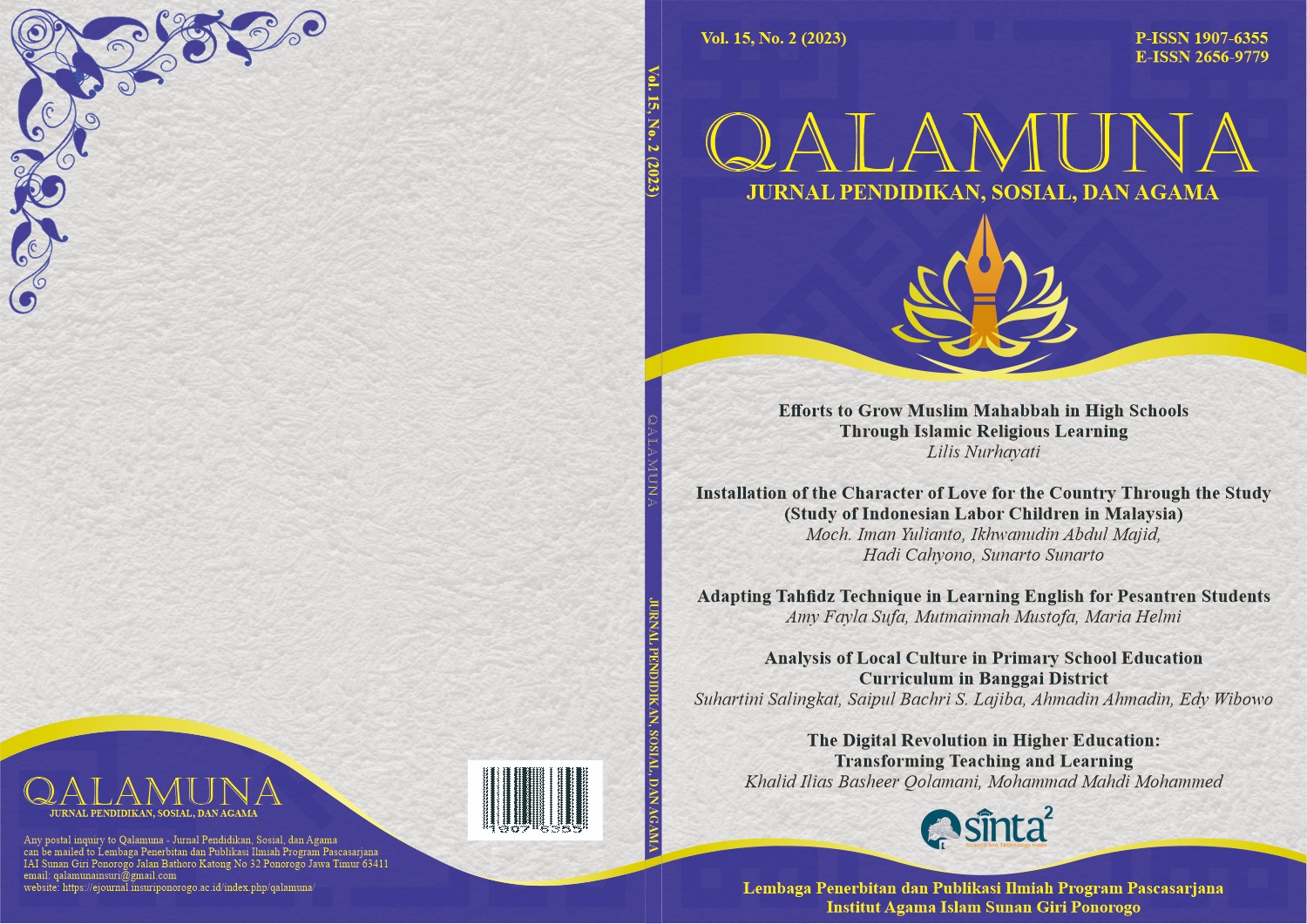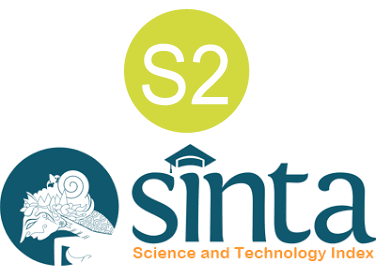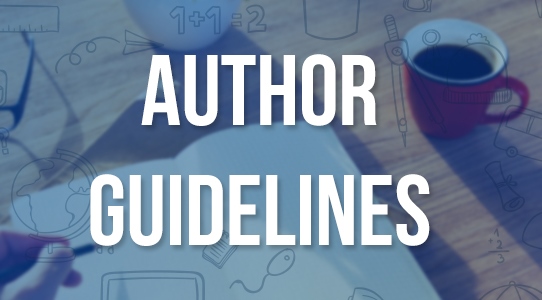Celebrating Interfaith Rituals to Build Togetherness Between Children in Elementary Schools
DOI:
https://doi.org/10.37680/qalamuna.v15i2.3395Keywords:
Interreligious Ritual, Ritual Communication, TogethernessAbstract
This research aims to describe and interpret forms of interreligious rituals in primary schools. Researchers also look at children's religious expressions in practicing interreligious rituals and their contribution as learning resources in building a sense of togetherness in schools. This study uses a qualitative-phenomenological approach with data collection interviews, observations, and documentation. The results showed that children's religious rituals were taught in and outside the classroom. They practice with teachers of the same religion in class, but outside the classroom, they practice with students of other religions as spectators. Therefore, religious rituals that can be communicated socially are celebrated. Interreligious rituals do not make children and parents experience theological fear but can become a source of learning to recognize and respect other religious rituals. The ritual expression is an expression of harmony and togetherness because they can cooperate in celebrating their respective religious rituals.
References
Aguilar, S. J. (2018). Learning analytics: At the nexus of big data, digital innovation, and social justice in education. TechTrends, 62(1), 37–45.
Arnold, K. E. (2010). Signals: Applying academic analytics. Educause Quarterly, 33(1).
Bower, M., Lee, M. J., & Dalgarno, B. (2017). Collaborative learning across physical and virtual worlds: Factors supporting and constraining learners in a blended reality environment. British Journal of Educational Technology, 48(2), 407–430.
Brown, J. S., & Adler, R. P. (2008). Minds on fire: Open education, the Long Tail, and learning 2.0. Educause Review, 43(1), 16–20.
Caldwell, J. E. (2007). Clickers in the large classroom: Current research and best-practice tips. CBE—Life Sciences Education, 6(1), 9–20.
Chen, B., Knight, S., Wise, A., & Cheng, J. (2018). Critical issues in designing and implementing temporal analytics. Journal of Computing in Higher Education, 30(1), 27–47.
Dahlstrom, E., Christopher Brooks, D., & Bichsel, J. (2014). The Current Ecosystem of Learning Management Systems in Higher Education: Student, Faculty, and IT Perspectives.
Drachsler, H., & Greller, W. (2016). Privacy and analytics - it’s a DELICATE issue, a checklist for trusted learning analytics. ACM International Conference Proceeding Series, 25-29-Apri, 89–98. https://doi.org/10.1145/2883851.2883893
Graham, C. R., Woodfield, W., & Harrison, J. B. (2013). A framework for institutional adoption and implementation of blended learning in higher education. Internet and Higher Education, 18, 4–14. https://doi.org/10.1016/j.iheduc.2012.09.003
Hiltz, S. R., & Turoff, M. (2005). Education goes digital: The evolution of online learning and the revolution in higher education. Communications of the ACM, 48(10), 59–64. https://doi.org/10.1145/1089107.1089139
Ifenthaler, D., & Schumacher, C. (2019). Releasing the brake on data analytics in education. TechTrends, 63(1), 27–31.
Jaggars, S. S., & Xu, D. (2016). How do online course design features influence student performance? Computers and Education, 95, 270–284. https://doi.org/10.1016/j.compedu.2016.01.014
Janca, R. (2013). Linking quality and governance in higher education. Perspectives: Policy and Practice in Higher Education, 17(1), 2–6.
Johnson, L., et al. (2016). NMC Horizon Report: 2016 Higher Education Edition. In The New Media Consortium (higher edu, Issue 15018). http://www.nmc.org/publications/2014-horizon-report-higher-ed
Kamenetz, A. (2016). How One University Used Big Data To Boost Graduation Rates. National Public Radio, 35(12), 30–37. https://doi.org/https://www.npr.org/sections/ed/2016/10/30/499200614/how-one-university-used-big-data-to-boost-graduation-rates
Long, P., & Siemens, G. (2011). Penetrating the Fog: Analytics in Learning and Education. EDUCAUSE Review, 46(5), 30–32. http://search.proquest.com.proxy.library.vanderbilt.edu/docview/964183308/13AF5BC47C138E29FF2/5?accountid=14816%5Cnhttps://login.proxy.library.vanderbilt.edu/login?url=http://search.proquest.com/docview/964183308/13AF5BC47C138E29FF2/5?accountid=14816
Luckin, R., Holmes, W., Griffiths, M., & Forcier, L. B. (2016). Intelligence Unleashed: An argument for AI in education. In Pearson Education. Pearson. https://www.pearson.com/content/dam/one-dot-com/one-dot-com/global/Files/about-pearson/innovation/Intelligence-Unleashed-Publication.pdf
Nilson, L. B., & Goodson, L. A. (2021). Online Teaching at Its Best: Merging Instructional Design with Teaching and Learning Research. In Journal of Development Research (Vol. 13, Issue 4). John Wiley & Sons. https://doi.org/10.54366/jdr.13.4.2020.62-64
Picciano, A. G. (2012). The evolution of big data and learning analytics in American higher education. Journal of Asynchronous Learning Network, 16(3), 9–20. https://doi.org/10.24059/olj.v16i3.267
Prinsloo, P., & Slade, S. (2017). An elephant in the learning analytics room - The obligation to act. In ACM International Conference Proceeding Series. https://doi.org/10.1145/3027385.3027406
Roberts-Mahoney, H., Means, A. J., & Garrison, M. J. (2016). Netflixing human capital development: personalized learning technology and the corporatization of K-12 education. Journal of Education Policy, 31(4), 405–420. https://doi.org/10.1080/02680939.2015.1132774
Roehl, A., Reddy, S. L., & Shannon, G. J. (2013). The Flipped Classroom: An Opportunity To Engage Millennial Students Through Active Learning Strategies. Journal of Family & Consumer Sciences, 105(2), 44–49. https://doi.org/10.14307/jfcs105.2.12
Seaman, et al. (2018). Grade increase: Tracking distance education in the United States. Babson Park, MA: Babson Survey Research Group. In Babson Survey Research Group. Babson Survey Research Group. https://eric.ed.gov/?id=ED580852%0Awww.favazza.com
Siemens, G. (2013). Learning analytics: The emergence of a discipline. In New Ways to Teach and Learn in China and Finland: Crossing Boundaries with Technology (Vol. 57, Issue 10). American Behavioral Scientist. https://doi.org/10.1177/0002764213498851
Slade, S., & Prinsloo, P. (2013). Learning Analytics: Ethical Issues and Dilemmas. American Behavioral Scientist, 57(10), 1510–1529. https://doi.org/10.1177/0002764213479366
Taneja, S. (2014). DreamBox: An adaptive, personalized learning platform for early math education. Forbes, October, 20. https://doi.org/https://www.forbes.com/sites/sungardas/2014/10/20/dreambox-adaptive-personalized-learning-platform-early-math-education/
West, D., Huijser, H., & Heath, D. (2016). Putting an ethical lens on learning analytics. Educational Technology Research and Development, 64(5), 903–922. https://doi.org/10.1007/s11423-016-9464-3
Willis, J. E., Campbell, J. P., & Pistilli, M. D. (2013). Ethics, Big Data, and Analytics : A Model for Application. EDUCAUSE Review Online, 1.
Downloads
Published
How to Cite
Issue
Section
License
Authors who submit manuscript retain its copyright and grant publisher right of first publication licensed under a Creative Commons Attribution-ShareAlike 4.0 International License (CC BY-SA 4.0) that allows others to access (search, read, download, and cite), share (copy and redistribute the material in any medium or format) and adapt (remix, transform, and build upon any material) the work for any lawful purpose, even commercially with an acknowledgement of the work's authorship and initial publication in Qalamuna: Jurnal Pendidikan, Sosial, dan Agama.












